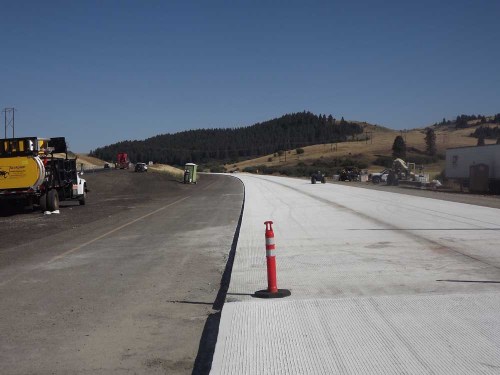Ladd Canyon project rolls toward end
Published 9:00 am Saturday, August 8, 2020

- The new concrete lanes through the Ladd Canyon portion of Interstate 84 south of La Grande cost more upfront than asphalt but will last longer under the strain of heavy semitrailers.
UNION COUNTY — People who drive frequently through Ladd Canyon may feel like they have received an early Christmas present this November.
The Oregon Department of Transportation is making major progress in the final phase of the $30 million Ladd Canyon Freight Improvement Project, including the installation of a 2-mile eastbound lane starting from its west entrance.
Trending
“It should be ready by November,” said Ken Patterson, area manager of the ODOT office in La Grande.
The expanded space should reduce the number of times the state road agency has to close the freeway through Ladd Canyon for semitrailers blocking lanes after jackknifing. Patterson said if a truck crashes in the future on the three-lane road, traffic will be able to move around it while crews clear the wreck.
Now when this happens, the freeway often must close.
Ladd Canyon soon will be the fourth site on Interstate 84 in Northeast Oregon where ODOT has installed a third lane. The others are Farewell Bend, Spring Creek and Cabbage Hill.
Patterson said road closures due to jackknifed trucks have fallen significantly at those three sites since the addition of the third lanes beginning in the late 1990s.
“They have made a huge difference,” Patterson said.
Trending
He anticipates the impact also will be great in the eastbound entrance into Ladd Canyon, where numerous semitrailers jackknife most winters.
At Ladd Canyon, the roadway with a third lane will consist of two new concrete lanes and a third with new asphalt. Passenger vehicles will be able to drive in all three lanes, but trucks will be restricted to the two concrete lanes.
Patterson said the three-lane east set-up provides car drivers with a lane to pass slower moving semitrailers, thus preventing getting stuck between large semis. Patterson said large trucks sometimes roll at only 20 miles per hour on the uphill passage while many cars are traveling at least 70 miles per hour.
The truck lanes are made out of concrete instead of asphalt because it will hold up better under the weight of heavier vehicles.
“We expect them to last for 50 years,” Patterson said.
Concrete is more expensive than asphalt but has greater longevity, which will save the state money.
“There is more of an upfront cost, but it is worth it in the long run,” Patterson said.
He also said he anticipates there will be fewer repair costs for the concrete lanes during their lifespan. The asphalt lane, by contrast, will need extensive work, including patching, he added.
The only problem Patterson anticipates with the concrete lanes is semis will wear ruts into them. To address this, the lanes are 11 inches thick. This will allow ODOT crews to slice off the ruts and even out the concrete surface later, while leaving enough roadway for trucks to continue traveling.
The Ladd Canyon Freight Improvement Project started in April 2019. In that first year, crews widened the shoulders of the east- and westbound lanes of Interstate 84 for 10 miles between La Grande and Ladd Canyon, removed a bridge and installed a concrete box-like culvert large enough to accommodate semitrailers. Eliminating the bridge was beneficial because it tended to get icy.
Work on the second phase of the project started in April this year. Traffic through the construction area is restricted to 50 miles per hour.
Patterson said drivers generally are obeying the speed limit, but there were major exceptions this spring.
“We had two drivers go through at over 100 miles per hour in a couple of days,” he said.
Since then, though, there have been few major problems thanks in part to Oregon State Police troopers, who Patterson credited with doing an excellent job of patrolling the work site.
“The OSP has made a big difference,” Patterson said. “It gets a lot of attention and respect.”









